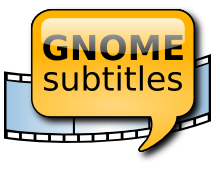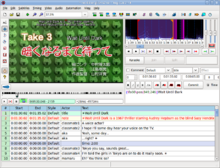
LaTeX is a software system for document preparation. When writing, the writer uses plain text as opposed to the formatted text found in WYSIWYG word processors like Microsoft Word, LibreOffice Writer and Apple Pages. The writer uses markup tagging conventions to define the general structure of a document, to stylise text throughout a document, and to add citations and cross-references. A TeX distribution such as TeX Live or MiKTeX is used to produce an output file suitable for printing or digital distribution.

Closed captioning (CC) and subtitling are both processes of displaying text on a television, video screen, or other visual display to provide additional or interpretive information. Both are typically used as a transcription of the audio portion of a program as it occurs, sometimes including descriptions of non-speech elements. Other uses have included providing a textual alternative language translation of a presentation's primary audio language that is usually burned-in to the video and unselectable.
Desktop publishing (DTP) is the creation of documents using page layout software on a personal ("desktop") computer. It was first used almost exclusively for print publications, but now it also assists in the creation of various forms of online content. Desktop publishing software can generate layouts and produce typographic-quality text and images comparable to traditional typography and printing. Desktop publishing is also the main reference for digital typography. This technology allows individuals, businesses, and other organizations to self-publish a wide variety of content, from menus to magazines to books, without the expense of commercial printing.

A fansub is a version of a foreign film or foreign television program, typically anime or dorama which has been translated by fans and subtitled into a language usually other than that of the original.

LyX is an open source, graphical user interface document processor based on the LaTeX typesetting system. Unlike most word processors, which follow the WYSIWYG paradigm, LyX has a WYSIWYM approach, where what shows up on the screen roughly depicts the semantic structure of the page and is only an approximation of the document produced by TeX.
The following comparison of video players compares general and technical information for notable software media player programs.

LiVES (LiVES Editing System) is a free and open-source video editing software and VJ tool, released under the GNU General Public License version 3 or later. There are binary versions available for most popular Linux distributions (including Debian, Ubuntu, Fedora, Suse, Gentoo, Slackware, Arch Linux, Mandriva and Mageia). There are also ports for BSD, and it will run under Solaris and IRIX. It has been compiled under OS X Leopard, but not thoroughly tested on that platform. In early 2019, a version for Microsoft Windows was announced, with a release slated for in the second half of 2019.

Avidemux is a free and open-source software application for non-linear video editing and transcoding multimedia files. The developers intend it as "a simple tool for simple video processing tasks" and to allow users "to do elementary things in a very straightforward way". It is written in C++ and uses Qt for its graphical user interface, and FFmpeg for its multimedia functions. Starting with version 2.4, Avidemux also offers a command-line interface, and since version 2.6, the original GTK port has not been maintained and is now discontinued.
Wintermute Engine (WME) is a set of software tools and a runtime interpreter primarily designed for creating and running graphical adventure games.
SubRip is a free software program for Microsoft Windows which extracts subtitles and their timings from various video formats to a text file. It is released under the GNU GPL. Its subtitle format's file extension is .srt and is widely supported. Each .srt file is a human-readable file format where the subtitles are stored sequentially along with the timing information. Most subtitles distributed on the Internet are in this format.

Subtitles are text representing the contents of the audio in a film, television show, opera or other audiovisual media. Subtitles might provide a transcription or translation of spoken dialogue. Although naming conventions can vary, captions are subtitles that include written descriptions of other elements of the audio like music or sound effects. Captions are thus especially helpful to people who are deaf or hard-of-hearing. Other times, subtitles add information not present in the audio. Localizing subtitles provide cultural context to viewers, for example, by explaining to an unfamiliar American audience that sake is a type of Japanese wine. Lastly, subtitles are sometimes used for humor, like in Annie Hall, where subtitles show the characters' inner thoughts, which contradict what they were saying in the audio.

Gnome Subtitles is an open-source subtitle editor for the GNOME desktop, based on Mono. It supports the most common text-based subtitle formats, video previewing, timings synchronization and subtitle translation.
Universal Subtitle Format (USF) was a CoreCodec project that attempted to create a clean, documented, powerful and easy to use subtitle file format. It is based on XML for flexibility, unicode support, hierarchical system, and ease of administration.

DVD Flick is an open source DVD authoring application for Windows developed by Dennis Meuwissen and released under the GNU General Public License. DVD Flick is capable of importing audio tracks, video files and subtitles, composing a DVD-Video movie and burning it to a disc – or creating an ISO image for later burning.
Fan translation refers to the unofficial translation of various forms of written or multimedia products made by fans, often into a language in which an official translated version is not yet available. Generally, fans do not have formal training as translators but they volunteer to participate in translation projects based on interest in a specific audiovisual genre, TV series, movie, etc.
MicroDVD is a subtitle file format for digital video. Its name is derived from the MicroDVD Player, a media player application designed to play DVD videos along with subtitles, originally developed by Tiamat Software. The application was first released in 2000 but development ended in 2001. Media players that support the format are able to interpret MicroDVD subtitles and mix their contents with their corresponding video files.
A subtitle editor is a type of software used to create and edit subtitles to be superimposed over, and synchronized with, video. Such editors usually provide video preview, easy entering/editing of text, start, and end times, and control over text formatting and positioning. Subtitle editors are available as standalone applications, as components of many video editing software suites, and as web applications.

Subtitle Edit is a free and open-source subtitle editor to create, edit, adjust or synchronize subtitles for videos.
Multimedia translation, also sometimes referred to as Audiovisual translation, is a specialized branch of translation which deals with the transfer of multimodal and multimedial texts into another language and/or culture. and which implies the use of a multimedia electronic system in the translation or in the transmission process.










